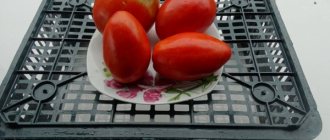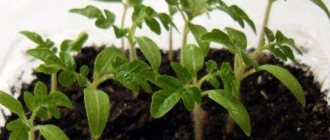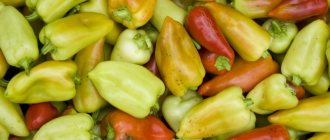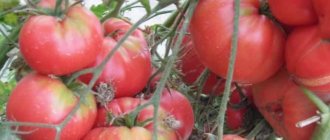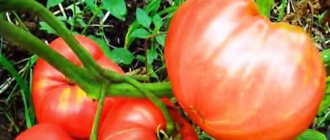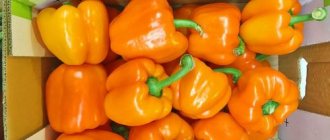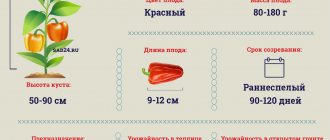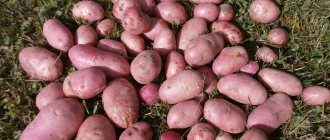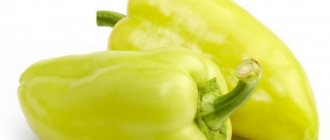History of the variety
The Cypress tomato appeared on the consumer market recently. The variety was obtained by Russian breeders in 2013. Having passed all tests in accordance with the regulations, the vegetable crop was included in the State Register in 2015. Since that time, the Cypress tomato began to be cultivated in all regions of Russia.
We suggest you read: How to cure the soil from late blight in the fall
Taking into account the description of the variety, the vegetable crop shows good yield indicators in open ground in the southern part of the country. In the middle zone, it is advisable to grow tomatoes under film covers. In Siberia and the Urals, the variety is recommended to build heated greenhouses.
Features of culture
Tomato Cypress - late ripening. The first harvest occurs at the end of summer, but fruiting continues for quite a long time, until the first frost.
Description of the variety:
- determinate bush, standard type;
- The average plant height is 80–90 cm;
- tomato is heavily leafy;
- the leaf is large, dark green in color;
- the fruits are arranged compactly.
The description of the variety also includes the location of the fruits. They fit quite compactly to the trunk of the plant and hang from it in beautiful clusters.
The vegetable is very light-loving from the moment of seed germination to harvest. So, when choosing a variety, you need to take a closer look at the conditions of your garden and its location. Unique rare peppers are usually very attractive and are a decoration for home gardens. However, in the absence of proper care, even the most resistant hybrids will be unproductive.
Even beginners can grow non-standard peppers. After all, the vegetable has beneficial properties that help it adapt to the environment.
The gardener must provide the crop with the basic factors: lighting, normal temperature, fertile soil. If the plant is in the wind, shelter is necessary.
Let's tell you more about the best original varieties of pepper.
Bitter varieties
Chilly Willy
It looks so unusual that even ardent supporters of standard peppers are interested. This variety is expensive and very rare. When ripe it turns yellow, orange or red. In summer it grows even in open ground; indoors it can delight you with interesting fruits all year round. Peppers are consumed fresh, dried, salted, or pickled. The fruits are always bright and not very hot in taste.
Filius Blue
One of the decorative varieties suitable for consumption. The color of the pods is first purple, then becomes yellow, orange, and bright red. Several plants form a miniature flowerbed. The bushes are low, 45 cm. They have original purple leaves. The berries are small, cone-shaped. Peppers become less spicy as they ripen, but at the beginning of their formation they are very hot. Grown by seedling method.
Black olive
A beautiful decorative variety. The leaves of the plant are dark purple and the pods are almost black. When ripe, they turn red. The short berries, 2-3 cm in size, are bullet-shaped. The bushes are small, about 60 cm, beautiful, with large branches, which makes the fruits even more original.
It is used to make various dishes, as well as sauces and pickles. These peppers taste very hot. The variety is unpretentious and is grown in seedlings.
YELLOW MUSHROOM
The result of selection, which is preferred by supporters of unusual plants. Some gardeners use it simply to decorate the site. The shape of the fruit resembles a mushroom. The pods are very sharp. The bushes are medium, with high productivity. The berries are small, 3 cm long, 6 cm wide. They are considered a variety of Habanero. Grows in nutritious soils, good light, and warm climates. Grown by seedlings.
Growing rules
Reviews from those gardeners who have already tried the Cypress vegetable crop agree that it is better to form a tomato into 3-4 stems in open ground and 2 stems in greenhouse conditions. The plant is grown using the following technology:
- In early spring, holes of 30x40 cm are dug, with an interval of 1 m from each other.
- The bottom of the pit is loosened with a pitchfork and fertilized with rotten manure and high-quality humus.
- A stake more than 1.5 meters high is dug into the hole.
- Once frosts have passed, 3–4 seedlings are planted in one hole.
- After filling and compacting the plant, water it abundantly with warm water.
- 5 days after planting, the seedlings are tied to a support and fed with nitrogen fertilizers.
Further care consists of pinching, timely watering and prevention against pests.
So, having examined the characteristics of the Cypress tomato, its yield and description of the fruit, you can see for yourself that this is a good find for gardeners. By planting and growing this crop, everyone will be able to enjoy fresh and tasty tomatoes in late summer. And the decorative appearance of the plant, which resembles a cypress tree, will decorate the garden area.
The bushes are tied to vertical supports and shaped if necessary.
Water with warm water in the mornings or evenings. Water is carefully poured under the root so as not to get on the leaves. Watering is required regularly, but not excessively.
Feed three times a season: once before flowering and twice after. They use mineral complexes for peppers with nitrogen, potassium and phosphorus. Expert opinion Valentin Redko Editor-in-Chief Repka.online. Experienced summer resident and gardener. Pepper Cypress F1 bears fruit consistently and does not require special care.
Among the features of the Cypress variety are its excellent productivity, high resistance to diseases, and tolerance to lack of moisture. It is also worth highlighting the shelf life of the fruit and good transport tolerance.
If you grow “Cypress” in a greenhouse shelter, then the bush should be formed into three stems, in open ground into four. The trunk needs garter, and the branches need supports, as they can experience very strong loads under the weight of the fruit. At all stages of growth it responds very well to complex feeding.
You can learn more about fertilizers for tomatoes from the articles on the site:
- Organic, mineral, phosphorus, complex and ready-made fertilizers for seedlings and the TOP best.
- Yeast, iodine, ammonia, hydrogen peroxide, ash, boric acid.
- What is foliar feeding and when picking, how to carry it out.
There are differences when growing in greenhouses and open ground. Under greenhouse conditions, the bush is formed by three stems, and in the ground - by four. The trunk of the plant must be tied up regularly, and supports must be placed for the branches, as they can easily break under the weight of the fruit.
During the entire growing period, the tomato needs to be fed using complex fertilizers.
... and everything around her
Let's start with a gallery of portraits of peppers. I won’t write captions for the photos; I described all the varieties of bell peppers in the article.
Pepper in a greenhouse.
A productive pepper bush.
Each is 250 grams.
Beginning of September. Those same 27 buckets of pepper.
, varieties of bell pepper and other companies were now grown I’ll say right away that they pleased and did not please at the same time.
Those that I received from a Chelyabinsk company were grown only in a greenhouse. For several years in a row the weather was neither sunny nor warm. Therefore, even though the varieties of bell pepper , one might say all-weather, they could not grow a good harvest due to weather conditions and by definition...
Desert heat in Altai.
And now an extraordinary heat has arrived, about which they said that nothing like this had happened in our area for 120 years. The greenhouses turned into steamy sections of bathhouses, only the humidity was not great, and the heat was such that the leaves, even after watering, withered at noon. And if it was possible to cover the sunny side in the cucumber greenhouse, then there was nothing to cover the two hottest sides of the tomato greenhouse, in which the peppers grew.
Of course, the beds with tomatoes and peppers were watered differently, in accordance with the requirements of the culture, but the beds were also filled with plants, taking into account their height. The peppers are lower than the tomatoes, which means they ended up in the beds that were located closer to the glass. So that there is enough light and sun for everyone. And this summer it turned out to be too sultry, too bright.
Therefore, the fruits on the plants managed to set from the first flowers, and then, after the heat passed, after 2 months, from the last flowers. The harvest was small. And the fruits did not match the description. Judge for yourself.
Cypress.
“Cypress” was not at all a beautiful openwork bush, which was supposed to bear heavy fruits up to 200 grams until the fall. He managed to stretch out while in the sun. The peppercorns grew as in the picture, only there were few of them. And they reached biological ripeness, when the fruits turn red, only in mid-September.
When this happened in the open field, it would not be something horrifying. But they were planted in the ground in a greenhouse at the end of April from individual bags without damaging the root system.
Jupiter.
“Jupiter” was presented as a hybrid adaptable to any conditions. In the greenhouse in the summer of 2012, he was unable to adapt to the heat. There were fruits, they were no different from their own portraits, but there were also few of them.
Favorite.
“Favorite” did not disappoint only in height, he was able to grow his announced 120 centimeters. But it did not become impressive, similar to a monumental sculpture. He fell without a garter. And I couldn’t be proud of the particularly large fruits either. Although a few of them grew, the rest turned out to be ordinary with the usual size of the fruit.
This hybrid would be chosen because the weight of the fruit is 340 grams, and this is not the first pepper like this to grow, but almost all of them. What a relief it is for the housewife when preparing dinner: she has peeled one single fruit and it is enough for soup and salad. For winter preparations this is generally a blessing.
Pythagoras.
As promised, it was the same in all directions. Beautiful and large, but low-yielding. Although the breeders promised that it would produce 13 kilograms per square meter. This is when planting 50x50.
Varieties of bell peppers from the store.
I love peppers; they, like zucchini, pumpkin and cabbage, are my favorite vegetables. That’s why I grow not 10-20 plants, but 150.
Therefore, 35 roots of Chelyabinsk wonderful peppers were supplemented with those bought in the store. They didn’t get any space in the greenhouse; everything was given to the exotics.
It’s a pity that I didn’t dare to plant at least 2-3 pieces in open ground. Although in fact it was truly a pity. After all, this spring has been very cold and long: throughout May there were frosts at night from -1 to -10 degrees. And the greenhouse was heated by an infrared radiator.
Varieties of bell peppers fell into the soil .
Early ripening peppers of the varieties “Bugai” with a soft yellow color and fruits weighing up to 500 grams, “Flamenco” with bright red fruits measuring 10x15, “Gourmet” are bright orange, fragrant, tender. And also “Apricot Favorite”, the name of which accurately determines the color of the fruit, but not the weight; it does not exceed 120 grams.
Mid-season Bulgarians “Sphinx” are bright orange, cone-shaped and “Nugget” with dark red fruits measuring 12x12 centimeters and weighing up to 200 grams.
They were all great in the ground. Maybe because at least they had coolness at night, but they didn’t have enough water in the open ground. For two months, with the terrifying heat, there was not a single rain, and during this misfortune, hot winds also swept away all the moisture from the soil. The earth dried out and cracked.
And what is the harvest?
Overall good.
But the variety, or rather the hybrid, “Gourmet” is not gourmet at all, the color is dirty dull orange with dust. The peppers are very small, and in such heat they also managed to spoil right on the bush.
The overall yield is high, the fruits are quite large. Delicious, almost all ripened before the first (more often promised than real) cold spells and frosts arrived in early September.
When I had to remove the fruits en masse, it turned out that I had to take 27 buckets of beautiful peppercorns from the beds to the greenhouse. But all summer we still ate them and made preparations for the winter.
Quite a decent harvest. This year, if the catalog of Chelyabinsk breeders includes bell peppers, the varieties of which I grew in the greenhouse today, I will buy it again and try it again. I hope that in the new summer the climate will be normal for our area, and the garden will not turn into a desert.
Yield Characteristics
The Cypress tomato variety is quite productive. With proper care and adherence to agricultural technology, more than 7 kg of beautiful and nutritious fruits can be harvested from one bush.
Fruit characteristics:
- the average weight of a tomato is 90–110 g;
- the skin of the tomatoes is deep red;
- The tomato pulp has a dense consistency and an attractive pink hue.
- the taste of fruits on a 5-point scale is estimated at 4.8 points.
Unlike other similar crops, all tomatoes of the Cypress tomato have the same appearance, regular rounded shape. This feature allows you to prepare an original whole-fruit preserve that will decorate any table.
With proper and careful care, you can get up to 8 kg of tomatoes from one bush. Recommended planting density: per 1 sq.m. 3-4 sprouts, if you follow this order, you can get up to 25 kg from them. For this variety, with its average height, these are very good indicators.
We suggest you read: Hot chili peppers: benefits and harms
Sweet varieties
Kolobok
Semi-standard version. It is a low, neat, densely leafed bush with a height of 0.45 m. It is distinguished by unusual beautiful berries. Productivity: 5 kg. from 1 sq. m. Can grow in a greenhouse and in the garden. Optimal planting pattern: 30*40. Mature pods are red, round, weigh 170 grams. Pepper is distinguished by its pronounced aroma, resistance to diseases, early formation of fruits and good yield. The wall thickness is 1 cm. The variety needs to be mulched, properly watered and fed. A good choice for summer residents.
Blot
Medium-ripe non-standard colored and highly productive pepper. 3.5 kg is formed per square meter. fruits The bushes are semi-spreading, not very tall. Juicy peppers are colored purple and can brighten up any area. Wall thickness 6 mm, pod weight 130 grams. The variety is not afraid of verticillium. Can be cultivated by seedlings in any soil. Sowing is carried out according to the 40*60 scheme and begins after March 10. The culture needs light and fertile soil. The pods can be eaten at the end of July.
Ingrid
The variety is interesting for pepper fans. It belongs to the mid-season, the growing season is 130-140 days. It is distinguished by high yield, original color and shape of the fruit. It is painted in burgundy-chocolate color and has a cubic shape. The berries are large, each weighs about 220 grams, the wall thickness is 10 mm. The bushes are strong and tall. Grown by seedling method. The seeds are sown at the end of winter. When two leaves appear, the seedlings dive. The plant needs to be fed with complex compounds. Before planting, seedlings are hardened off, since pepper is sensitive to frost. The landing pattern has dimensions 40*60. The soil needs to be loosened and provided with water.
Tamina
Early ripening high-yielding hybrid. Can be grown in open and closed ground. The growing season is 65 days. The bushes are low and strong. Fruit type - Ratunda or Gogoshara. The berries are thick-walled, up to 8 cm, tasty, juicy. This pepper is valued for its good preservation and resistance to transportation, immunity to infections, and sweet taste. Can be consumed raw and included in preserves.
Snowwhite
Early hybrid pepper. A variety with high yield. Type - wax Hungarian. It is grown in the garden and in greenhouses. The peppers are large, weighing about 160 grams. The berries are cone-shaped with four segments. The wall thickness is 6 mm. The color of the fruit is very interesting: first milky, then bright orange. It has a sweet taste. The bushes are tall, have developed roots and dense foliage. This is why the plant can withstand drought so easily. The variety is immune to diseases, has good marketability, productivity and endurance. There can be no more than 3 specimens per 1 square meter in a greenhouse, and no more than 4 in a garden bed.
You may be interested in: Favorable days for planting pepper for seedlings in 2021: terms and rules for sowing at home Favorable days for picking pepper in 2021 according to the lunar calendar Favorable days for sowing sweet and bitter pepper for seedlings in 2021
White cloud
Sweet mid-season variety bred in America. The bushes are average. Ripe fruits are round-block in shape and weigh up to 150 grams. The color of the pods changes from cream to red or orange. The berries have juicy walls, which is why the variety is so popular. The bushes are actively bearing fruit.
Advantages and disadvantages
The Cypress tomato is a new vegetable crop, so it is currently irrational to talk about all its pros and cons. However, the description of the variety guarantees such positive qualities as:
- consistently high productivity;
- good transportability;
- high immunity to infections;
- drought resistance;
- long shelf life.
At the moment, no tangible deficiencies have been identified in the culture. But in order to increase the quality of the Cypress tomato according to the recommendations of experts, it is worth adhering to several rules in agricultural technology.
Among the main advantages of this new variety are the following:
- very good yield indicator;
- high taste qualities;
- disease resistance;
- high commercial properties.
Due to the fact that the species is very young, no significant complaints have been identified against it.
Pepper Cypress F1 sweet
Until autumn, on the beautiful, tall and openwork “Cypress” bush, juicy, record-breakingly fleshy fruits with a wall thickness of 10 mm, which in appearance strongly resemble elastic, ripe tomatoes, will turn red and become heavy. Each of these heavy “tomatoes” weighs 180-200 g and has spattering-juicy pulp. The fruits tolerate long-distance transportation and long-term storage. "Cypress" has absolutely regular branching of the bush. Looking at it, you cannot help but think that this is some fantastically beautiful structure designed by a brilliant architect. Planting pattern 60x60 cm.
Where is the best place to grow tomatoes?
| Variety name | Cypress |
| general description | Mid-season determinate variety |
| Originator | Russia |
| Ripening period | 100-105 days |
| Form | Round |
| Color | Red |
| Average weight of tomatoes | 80-120 grams |
| Application | Universal |
| Productivity of the variety | up to 25 kg per sq.m |
| Features of cultivation | Standard agricultural technology |
| Disease resistance | Resistant to major diseases |
This is a mid-early tomato, from the moment the seedlings were planted until the first ripe fruits, 100-105 days pass. The plant is determinate, standard. The bush is medium-sized from 80-95 cm. It grows well in unprotected soil and in greenhouse shelters. It has complex resistance to diseases and pests.
The fruits are red, round in shape, not very large, weighing from 80-120 g. At the first collection they may be slightly larger than 120-130. The number of nests is 3-4, dry matter contains about 5-6%. The collected fruits ripen well if picked slightly unripe and can be stored for a long time and tolerate transportation well.
| Variety name | Fruit weight |
| Cypress | 80-120 grams |
| Grapefruit | 600-1000 grams |
| Lazy | 300-400 grams |
| Andromeda | 70-300 grams |
| Mazarin | 300-600 grams |
| Shuttle | 50-60 grams |
| Yamal | 110-115 grams |
| Kate | 120-130 grams |
| Early love | 85-95 grams |
| Black Moor | 50 grams |
| Persimmon | 350-400 |
Every vegetable grower is looking for more and more new varieties to plant. We present to your attention the Cypress tomato.
Based on the characteristics of the variety, we can say that the south and relatively warm latitudes are suitable for growing it in open ground. These include: Voronezh, Astrakhan, Belgorod regions and Crimea.
In the middle zone, it is better to create greenhouse conditions for tomatoes, in some even heated ones. It is worth noting here that in the northern regions the climate negatively affects the taste of tomatoes, and the yield is also significantly reduced.
Positive points:
- high productivity;
- excellent taste;
- disease resistance;
- high-quality commercial qualities.
The variety is still very young, so no negative characteristics have been identified yet.
Evergreen cypress f. pyramidal (Cupressus sempervirens f.stricta) 100 gr.
Cypress lat. Cupressus Cypress Family (Cupressaceae)
The genus includes about 20 species of evergreen trees or shrubs growing in the warm temperate zone of the Northern Hemisphere. The branches of cypress trees branch in different planes, less often in one, and are covered with scale-like, cross-paired needles, which in youth are needle-shaped. The cones are round, with numerous thyroid scales, and ripen in the second year. Propagated by seeds and cuttings.
Kinds:
Abrams cypress (Cupressua abramsiana) A small evergreen tree up to 10 m tall, rarely up to 25 m or more. The bark is gray, with a fibrous, chewy texture that is scattered on old trees. The leaves are bright green or yellowish-green, scale-like, about 1-1.5 mm long, the tips of the leaves spread slightly along the vigorous shoots. The cones are ovoid, 2-3 cm long and 1.5-2.2 cm wide, with eight or ten scales arranged in opposite decissate pairs, with a bloom visible as nothing more than a small lump or short root on the scales. The seeds are 3-5 mm long, bluish-brown, with a pair of small wings on the sides. The cones remain closed on the trees for many years until the trees are killed by a forest fire. After the tree dies, the cones open to release the seeds, which can then germinate successfully.
Arizona cypress (Cupressus arizonica) Southwestern USA. Conical coniferous tree 10-15 m tall and 4-5 m wide, with smooth, reddish-purple bark. Pointed, gray-blue leaves with resinous glandular spots, located densely on the branches. Spherical, spiny, brown female cones, 2.5 cm in diameter. Each cone has 6-8 scales.
Arizona cypress Stephenson (Cupressua arizonica var. stephensonii) Tree, erect or spreading, 10-16 m tall, crown span up to 10 m, with a trunk up to 70 cm in diameter, straight. The bark is thin, cherry-red, smooth, flaky, non-fibrous. Branchlets 10 mm long, 1.5-2 mm thick, approximately quadrangular. Young leaves are 1 mm long and 1 mm wide, sharp, abaxially rounded, often with an active gland, growing on shoots older than 1 year. Old leaves can reach 4-10 mm with a free tip 2-3 mm long, with a resin gland at the base of the free tip, with a lemon aroma. The edges of the leaves are ciliated, viewed under the lens. Pollen cones are 2 mm long and 2-4 mm thick, cylindrical or slightly pointed, with 10-12 scales, each with 3-5 pollen sacs. Seed cones are located at the tips of branches, green and 3 mm in diameter before pollination, turning brown and growing to 10 mm in diameter at the end of the first season, then dull gray, rough or warty, globose, up to 25 mm in diameter at the end of the 2nd season. The cones bear 100-125 seeds, very dark brown, 5 mm long and wide, with a light brown axis 2-3 mm long.
Cypress evergreen f. erect (Cupressus sempervirens f. stricta) The drought-resistant tree grows 25-30 meters high, with a straight trunk up to 50-60 cm in diameter and lives up to 2000 years. The shoots are 4-sided, the leaves are scaly, light green, reddish-brown in autumn. The cones are oblong-ovate with large shiny dark brown seeds.
Guadalupe cypress (Сupressus guadalupensis) Guadalupe cypress (Сupressus guadalupensis) USA, California. Tapered, conical, coniferous tree 15 m high and 3-4 m wide. The bark is red-brown, cracking with thin flakes falling off. The leaves are thin, blunt, pointed, bluish-green, 0.3 cm long, bearing thin shoots containing resin glands, fragrant when rubbed. The female cones are spherical, brown, 3-4 cm in diameter, each with 8-10 scales and protruding dorsal spines. The seeds ripen in October.
Himalayan cypress (Сupressus torulosa) An evergreen, coniferous tree 15-25 m tall, with a trunk 40-60 cm in diameter. The crown is large, oval or wide-conical. The bark is grey-brown or brown. The branches are cylindrical, almost 4-angled. The leaves are scaly, closely spaced, obtuse, dark green. Pollen cones are almost round, up to 0.6 cm long. Female cones are round or elliptical, on very short stalks, up to 2 cm in diameter, green or purple when young with 6-8 scales.
Cashmere cypress (Cupressus cashmeriana) Cashmere cypress (Cupressus cashmeriana) A medium-sized or large coniferous tree 20-45 m tall, rarely even higher, with a conical or narrow pyramidal crown with ascending or drooping branches and a trunk up to 3 m in diameter. The branches are flattened, 2-3 pinnate, compressed at the end. The leaves are bluish-green, grayish-green or iridescent in color, scaly, up to 0.2-0.5 cm long. Seed cones are spherical, ovoid, 1.2-2 cm long and 1-1.9 cm in diameter, with 8-12 scales, pale green when young, later dark brown. Pollen cones up to 0.5 cm long.
Lusitanian cypress (Сupressus lusitanica) Lusitanian cypress (Сupressus lusitanica) Tree 30-40 m high, with a wide pyramidal crown, in older specimens it is tent-shaped, spreading, with hanging ends of the branches. The trunk bark is reddish-brown, the shoots are tetrahedral, elongated, located in different planes. The needles are ovoid, tightly pressed, with pointed, spaced ends. The cones are numerous, almost spherical, up to 1.5 cm, young bluish-green, ripe - brown. Winged seeds. A fast-growing breed that does not tolerate dry air and soil, and is sensitive to cold. Reaches best development on deep, well-drained, alluvial, red soil soils. Durable.
McNab's cypress (Cupressus macnabiana) McNab's cypress (Cupressus macnabiana)Tree 10m. The needles are oval and dark green. The cones are spherical, gray-brown, 1.5 - 2.0 cm in diameter. The seeds ripen in September. Seeds in cones remain viable for up to 8 years. Stratification is required at 1 - 5 ° C for 30 days. Sowing in cold beds in winter.
Weeping cypress (Cupressus funebris) Weeping cypress (Cupressus funebris)An evergreen tree up to 18-35 m, with a trunk about 2 m in diameter. Branches drooping. The leaves are densely pressed to the branches, needle-like, about 0.15 cm long, pointed, with linear glands. When ripe, the cones are dark brown, spherical, 0.8-1.5 cm in diameter. Scales 6-8, 5-gonal.
Diseases and pests
No special problems with diseases were identified in the “Cypress” variety during the 2015 season. With good care, this is a very strong plant. Regular watering, ventilation of greenhouses and application of fertilizers, such measures will protect you from troubles.
Rare cases of tobacco mosaic and brown spot have been noted. It is not easy to deal with mosaic; you need to cut off all the affected shoots of the bush, and wash the cut areas with a light solution of potassium permanganate. Against brown spotting, use the “Barrier” product, and then reduce the humidity of the environment and increase air circulation. If your tomato grows in a greenhouse, then get ready for an uninvited visit from the greenhouse whitefly. The drug “Confidor” is successfully used against it.
Deep, thorough weeding of the soil and treating it with a water-pepper solution, which is poured into the pest’s habitat, will help against mole crickets in open ground. Spider mites can be washed off with soap and water until all signs of the pest disappear.
Like everything new, the “Cypress” variety can cause certain difficulties, since all its properties have not yet been fully established in real conditions. But it’s all the more interesting to get down to business, maybe you will be able to identify the subtleties in caring for this new variety. Good luck and new discoveries!
As mentioned earlier, no special diseases were observed during cultivation. With proper care the plant is very stable. To prevent diseases, you just need to remember to regularly water the bushes, ventilate the greenhouse and feed them with fertilizers. Over the entire period, only a few cases of tobacco mosaic and brown spot were observed.
Greenhouse whitefly is characteristic of greenhouse plants. Confidor is actively used to combat it.
In open ground, mole crickets and spider mites can cause inconvenience. Careful weeding will help remove the mole cricket, after which you need to treat the bushes with a solution of water and pepper. The product is poured into the places where mole crickets are found. Spider mites are easily washed off with a simple soap solution. You need to rinse until the pests are completely gone.
Conclusion When planting for the first time, anyone can experience difficulties growing a variety, but even beginners cope with this task. Having planted the Cypress variety, you will not regret making this discovery and not being afraid of difficulties. In the future, this type of tomato will become a permanent resident of your plot, and your neighbors will ask where you purchased it.
Tags: cypress, description, pepper
About the author: admin4ik
« Previous entry

